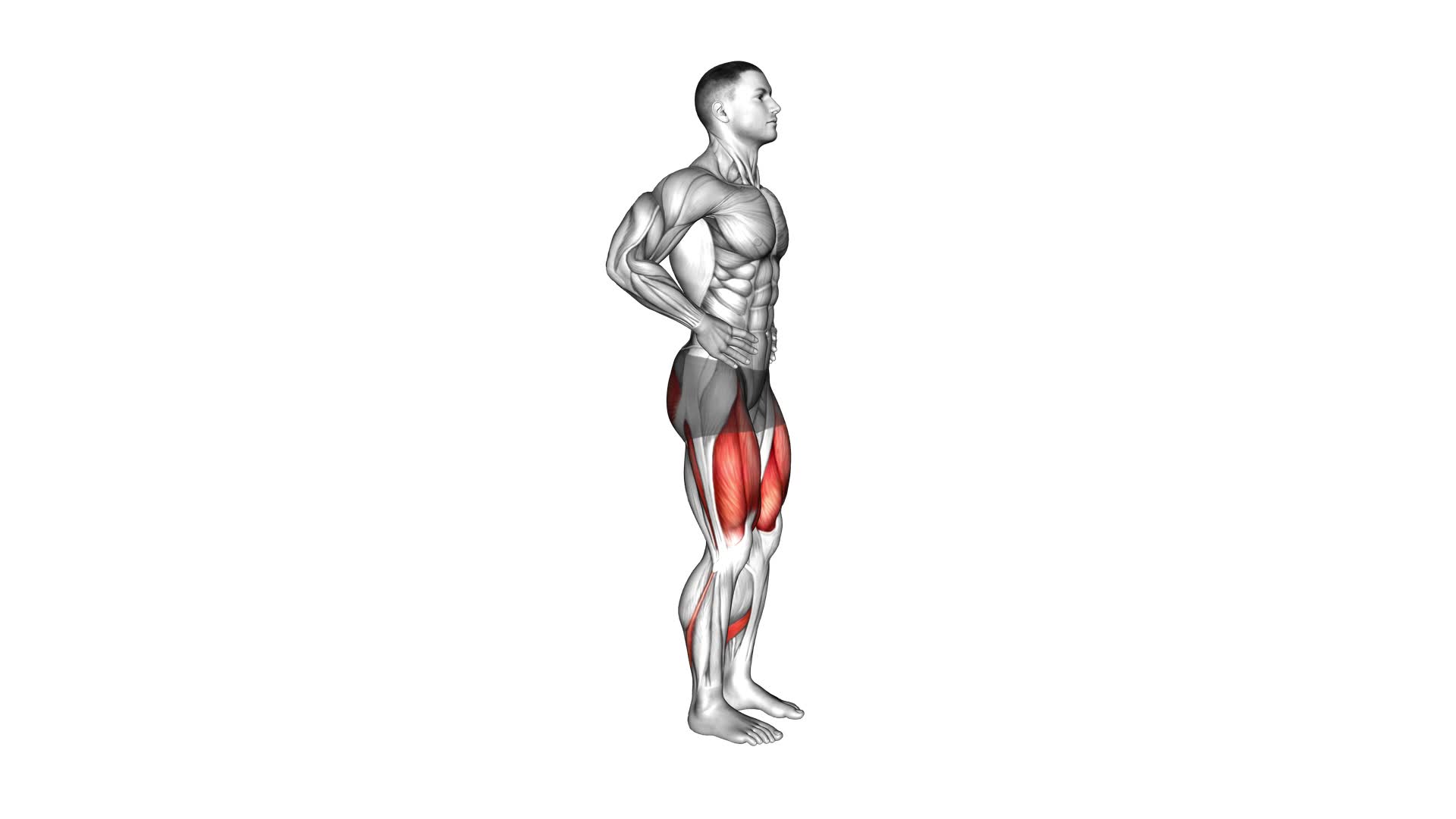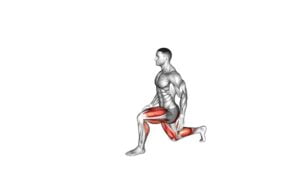Walking Lunge – Video Exercise Guide & Tips

Are you looking to level up your leg workout? The walking lunge is a fantastic exercise to strengthen your lower body and improve your balance.
Watch This Exercise Video
In this video exercise guide, we'll show you the proper form and technique for performing walking lunges.
You'll also discover variations to add some spice to your routine and common mistakes to avoid.
Follow our tips, watch the video, and get ready to maximize your results with the walking lunge.
Key Takeaways
- Walking lunge improves lower body strength and stability over time.
- It targets muscles in the legs, including quadriceps, hamstrings, and glutes.
- It aids in weight loss by increasing heart rate and burning calories.
- Proper form and technique, as well as incorporating variations, can maximize the benefits of walking lunges.
Benefits of the Walking Lunge
One of the benefits of incorporating walking lunges into your fitness routine is that they can help improve your lower body strength and stability over time. Lunges are a highly effective exercise for targeting the muscles in your legs, including your quadriceps, hamstrings, and glutes. By performing walking lunges regularly, you can increase the strength and definition of these muscles, leading to improved overall lower body strength.
In addition to building strength, walking lunges can also aid in weight loss. This exercise is a compound movement that engages multiple muscle groups simultaneously, which can help to increase your heart rate and burn calories. The more calories you burn, the more likely you're to lose weight.
Furthermore, walking lunges can be an excellent exercise for muscle toning. As you lunge forward and lower your body, you aren't only working the muscles in your legs but also engaging your core for stability. This can result in improved muscle tone and definition in your lower body.
Incorporating walking lunges into your fitness routine is a simple and effective way to improve lower body strength, aid in weight loss, and tone your muscles. So, grab a pair of dumbbells or just use your body weight and start lunging your way to a stronger, leaner physique.
Proper Form and Technique
To perform walking lunges with proper form and technique, you should focus on maintaining a stable and upright posture throughout the exercise. This is crucial to ensure that you engage the correct muscles and avoid any unnecessary strain or injuries.
One common misconception about walking lunges is that you need to take large steps. In reality, you should take smaller steps to maintain balance and control.
Another misconception is that you should let your knee touch the ground when lunging forward. However, this can put excessive pressure on your knee joint. Instead, aim to lower your body until your front thigh is parallel to the ground, without allowing your knee to go past your toes. This will help protect your knee and prevent injuries.
Speaking of injuries, the most common ones associated with walking lunges are knee and lower back injuries. These can occur if you don't maintain proper form or overload the exercise with excessive weight. To prevent these injuries, start with lighter weights and gradually increase the load as your strength and form improve.
Variations to Spice Up Your Workout
Looking to add some variety to your workout routine? Incorporating lunge variations into your workouts can help you target different muscles and challenge your body in new ways. Here are some advanced lunge techniques that you can try to spice up your workout.
- Reverse Lunge: Instead of stepping forward, take a step back with one leg. This variation puts more emphasis on your glutes and hamstrings.
- Curtsy Lunge: Cross one leg behind the other in a curtsy-like motion. This move targets your inner and outer thighs, as well as your glutes.
- Side Lunge: Step out to the side with one leg, keeping the other leg straight. Side lunges work your inner and outer thighs, as well as your glutes.
- Walking Lunge with Twist: As you step forward into a lunge, twist your torso towards the front leg. This engages your obliques and improves rotational stability.
- Jumping Lunge: Perform a lunge, then explosively jump and switch legs mid-air. This plyometric exercise increases power and cardiovascular endurance.
Common Mistakes to Avoid
To avoid common mistakes while performing walking lunges, make sure you maintain proper form and avoid these pitfalls.
One common mistake to avoid is allowing your front knee to extend past your toes. This places excessive strain on your knee joint and can lead to injury. Instead, focus on keeping your front knee directly above your ankle throughout the movement.
Another mistake to watch out for is leaning too far forward or backward. This can compromise your balance and stability, making it harder to perform the exercise correctly. To prevent this, maintain an upright posture and engage your core muscles to stabilize your body.
Lastly, avoid rushing through the movement. Walking lunges should be performed in a controlled manner, with each step taken deliberately and with proper form.
Now that you know the common mistakes to avoid, let's move on to the next section where we'll discuss tips for maximizing your results.
Tips for Maximizing Your Results
For the best results, focus on maintaining proper form and incorporating these tips into your walking lunge routine.
To maximize your results, it's important to fuel your body with the right nutrition. Prioritize a balanced diet that includes lean proteins, whole grains, fruits, and vegetables. These foods provide essential nutrients that support muscle recovery and growth. Additionally, staying hydrated is crucial for optimal performance. Be sure to drink enough water throughout the day, especially before and after your workouts.
In addition to nutrition tips, warming up properly is essential for maximizing your walking lunge routine. Before starting your lunges, spend a few minutes performing dynamic warm-up exercises. This can include leg swings, hip circles, and walking knee hugs. These exercises help increase blood flow, improve flexibility, and prepare your muscles for the lunge movement. Incorporating a warm-up routine into your exercise regimen can help reduce the risk of injury and improve overall performance.
Remember, consistency is key. Aim to incorporate walking lunges into your workout routine at least two to three times a week. Gradually increase the intensity and duration of your lunges over time to challenge your muscles and continue making progress.
Frequently Asked Questions
What Is the Recommended Number of Reps and Sets for the Walking Lunge Exercise?
For the walking lunge exercise, the recommended number of reps and sets depends on your fitness level and goals. Generally, it's suggested to start with 2-3 sets of 10-12 reps. However, if you have knee or lower back issues, modifications may be necessary.
It's important to listen to your body and consult with a fitness professional for personalized guidance. Remember to warm up properly and maintain proper form to avoid injury.
Can the Walking Lunge Be Modified for People With Knee or Lower Back Issues?
If you have knee or lower back issues, you may be wondering if there are modifications or alternatives to the walking lunge exercise. Good news! There are ways to modify the walking lunge to make it more knee and back friendly.
How Can I Incorporate the Walking Lunge Into a Full-Body Workout Routine?
To incorporate walking lunges into a full-body workout routine, start by adding them as a lower body exercise.
Walking lunges provide numerous benefits, such as strengthening your legs and activating the muscles in your glutes and hamstrings.
You can perform walking lunges with or without weights, and incorporate them into circuits or supersets for an effective full-body workout.
Just make sure to maintain proper form and engage your core throughout the movement.
Are There Any Specific Warm-Up Exercises That Should Be Done Before Performing the Walking Lunge?
Before performing the walking lunge, it's important to do a pre-lunge warm-up. This helps to prepare your muscles and joints for the movement.
You can start with some light cardio exercises like jogging or jumping jacks to get your heart rate up and increase blood flow to the muscles. Dynamic stretches like leg swings and hip circles can also help to loosen up your lower body.
Incorporating walking lunges into your routine can benefit your lower body strength by targeting your glutes, hamstrings, and quadriceps.
Can the Walking Lunge Help Improve Balance and Stability?
Yes, the walking lunge can definitely help improve your balance and stability. By incorporating this exercise into your routine, you won't only strengthen your glutes, but also improve your posture.
The walking lunge requires you to engage your core and maintain a steady balance as you move forward. This helps to improve your overall stability and coordination.
Conclusion
In conclusion, the walking lunge is a highly effective exercise that offers numerous benefits. It strengthens the lower body muscles and improves balance.
By following proper form and technique, incorporating variations, and avoiding common mistakes, you can maximize your results from this exercise.
So, lace up your sneakers and get ready to spice up your workout routine with the walking lunge!

Author
Years ago, the spark of my life’s passion ignited in my mind the moment I stepped into the local gym for the first time. The inaugural bead of perspiration, the initial endeavor, the very first surge of endorphins, and a sense of pride that washed over me post-workout marked the beginning of my deep-seated interest in strength sports, fitness, and sports nutrition. This very curiosity blossomed rapidly into a profound fascination, propelling me to earn a Master’s degree in Physical Education from the Academy of Physical Education in Krakow, followed by a Sports Manager diploma from the Jagiellonian University. My journey of growth led me to gain more specialized qualifications, such as being a certified personal trainer with a focus on sports dietetics, a lifeguard, and an instructor for wellness and corrective gymnastics. Theoretical knowledge paired seamlessly with practical experience, reinforcing my belief that the transformation of individuals under my guidance was also a reflection of my personal growth. This belief holds true even today. Each day, I strive to push the boundaries and explore new realms. These realms gently elevate me to greater heights. The unique combination of passion for my field and the continuous quest for growth fuels my drive to break new ground.







